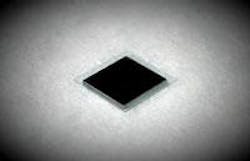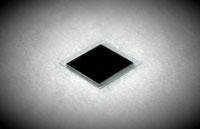Optically pumped vertical external-cavity surface-emitting lasers (VECSELs) can provide high power in a simple package. But while gallium arsenide-based VECSELs (which typically emit at a wavelength somewhere between 0.8 and 1.3 µm) can dump waste heat through their substrates, indium phosphide (InP)-based VECSELs (emitting between 1.4 and 1.6 µm) have a rougher time because InP conducts heat poorly.
Transparent heat spreaders can be bonded to the gain chip to conduct heat away while still transmitting the beam; however, the resulting etalon effect produces multiple peaks in the emission spectrum. In their quest for a high-power, single-frequency, long-wavelength VECSEL, researchers at the Chalmers Institute of Technology (Göteborg, Sweden) and the Royal Institute of technology (Kista, Sweden) have settled upon the use of a thin (50 µm thick) diamond heat spreader that simultaneously removes heat, performs spectral filtering, and stabilizes the laser’s wavelength.1,2,3
“Other crystalline materials that have been used for intracavity heat spreaders include silicon, silicon carbide, and sapphire; however, simultaneous use of the heat spreader as an etalon requires a thickness in the order of 50 µm,” says Hans Lindberg, one of the Chalmers researchers. “The benefits of these other materials, from a heat-transport point of view, are much reduced in such configurations due to their lower thermal conductivity.”
Heat spreader and filter
The VECSEL was grown on a 350-µm-thick InP substrate and contained a 48-period distributed Bragg reflector (DBR) for a rear mirror, a gain structure consisting of five groups of four indium gallium arsenide phosphide quantum wells (QWs) with spacers in between, and a 120-nm-thick InP window. The natural-diamond heat spreader was bonded to the structure, which was cooled by a copper heat sink. An external mirror with a 50‑mm radius of curvature and a reflectance of 99% was situated to form, along with the DBR, a 4-mm-long laser cavity. A beam from a Raman laser with a 1.25-µm wavelength and 5.5-W optical power was introduced at a slight angle to the normal and focused to a 250-µm spot on the gain region, stimulating the VECSEL to emit at near 1550 nm (see figure).The output for one of the experimental devices was a single line centered at about 1555.4 nm with a linewidth of less than 0.08 nm. The separation between the laser’s resonant wavelengths was 9 nm, determined by the thickness of the diamond heat spreader. The thin heat spreader thus enables single-frequency operation; in contrast, another, earlier laser similar except for the use of a thick (1.6-mm) diamond heat spreader produced a multiline spectral output spanning at least 6 nm.
A second VECSEL with a thin heat spreader emitting at 1548.5 nm had an emission linewidth of 200 MHz and produced 470 mW of optical power at 0°C and 170 mW at room temperature. It maintained single-frequency operation through the entire pump-laser power range, even when going through mode hops, of which there were two or three, depending on the temperature.
“We have been using natural single-crystal diamond, but we are looking into the possibilities of using various types of synthetic diamond for a more cost-effective solution,” says Lindberg. “The device we recently presented uses an uncoated diamond heat-spreader etalon in a conventional cavity. We believe that significant improvements in efficiency and spectral linewidth can be made by depositing an optimized surface coating on the diamond to reduce pump-light reflection and improve filtering characteristics.”
REFERENCES
1. H. Lindberg et al., IEEE Photonics Tech. Lett.17(7) (July 2005).
2. H. Lindberg et al., 2005 European Conf. on Lasers and Electro-Optics, paper CA-40 (June 12-16 2005).
3. H. Lindberg et al., Optics Lett. (Sept. 1, 2005).
About the Author
John Wallace
Senior Technical Editor (1998-2022)
John Wallace was with Laser Focus World for nearly 25 years, retiring in late June 2022. He obtained a bachelor's degree in mechanical engineering and physics at Rutgers University and a master's in optical engineering at the University of Rochester. Before becoming an editor, John worked as an engineer at RCA, Exxon, Eastman Kodak, and GCA Corporation.



